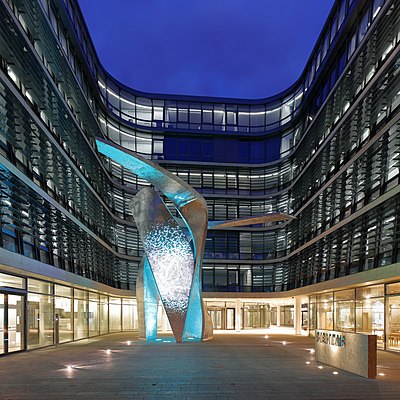
Search
Siemens

Siemens AG (Sebutan bahasa Jerman: [ˈziːmɛns]) ialah sebuah syarikat konglomerat Jerman yang beribu pejabat di Berlin dan Munich, dan ia merupakan syarikat industri perkilangan terbesar di Eropah ddengan pejabat-pejabat cawangan terdapat di merata dunia.
Bahagian utama syarikat Siemens ialah Industri, Tenaga, Kesihatan (Siemens Healthineers), dan Prasarana & Bandar, yang mewakili aktiviti-aktiviti utama syarikat. Syarikat ini merupakan syarikat terkemuka dalam pembuatan peralatan perubatan dan bahagian jagaan kesihatan perubatannya, yang menjana kira-kira 12% jumlah jualan syarikat ialah unit kedua paling menguntungkan, selepas industri automasi industri. Siemens adalah salah satu komponen dalam indeks pasaran saham Euro Stoxx 50. Siemens dan anak-anak syarikatnya menggajikan kira-kira 362,000 orang di seluruh dunia dan melaporkan pendapatan global mereka adalah sekitar € 75.6 bilion pada 2015 menurut laporan tahunan mereka.
Rujukan
Bacaan lanjut
- Weiher, Siegfried von /Herbert Goetzeler (1984). The Siemens Company, Its Historical Role in the Progress of Electrical Engineering 1847–1980, 2nd ed. Berlin and Munich.
- Feldenkirchen, Wilfried (2000). Siemens, From Workshop to Global Player, Munich.
- Feldenkirchen, Wilfried / Eberhard Posner (2005): The Siemens Entrepreneurs, Continuity and Change, 1847–2005, Ten Portraits, Munich.
- Greider, William (1997). One World, Ready or Not. Penguin Press. ISBN 0-7139-9211-5.
- Margarete Buber: 303f As prisoners of Stalin and Hitler, Frankf / Main, Berlin 1993
- See Carola Sachse: Jewish forced labor and non-Jewish women and men at Siemens from 1940 to 1945, in: International Scientific Correspondence, No. 1/1991, pp. 12–24; Karl-Heinz Roth: forced labor in the Siemens Group (1938 -1945). Facts, controversies, problems, in: Hermann Kaienburg (ed.): concentration camps and the German Economy 1939–1945 (Social studies, H. 34), Opladen 1996, pp. 149–168; Wilfried Feldenkirchen: 1918–1945 Siemens, Munich 1995, Ulrike fire, Claus Füllberg-Stolberg, Sylvia Kempe: work at Ravensbrück concentration camp, in: Women in concentration camps. Bergen-Belsen. Ravensbrück, Bremen, 1994, pp. 55–69; Ursula Krause-Schmitt: The path to the Siemens stock led past the crematorium, in: Information. German Resistance Study Group, Frankfurt / Main, 18 Jg, No. 37/38, Nov. 1993, pp. 38–46; Sigrid Jacobeit: working at Siemens in Ravensbrück, in: Dietrich Eichholz (eds) War and economy. Studies on German economic history 1939–1945, Berlin 1999.
- Bundesarchiv Berlin, NS 19, No. 968, Communication on the creation of the barracks for the Siemens & Halske, the planned production and the planned expansion for 2,500 prisoners "after direct discussions with this company": Economic and Administrative Main Office of the SS ( WVHA), Oswald Pohl, secretly, to Reichsführer SS (RFSS), Heinrich Himmler, dated 20 October 1942.
- Karl-Heinz Roth: forced labor in the Siemens Group, with a summary table, page 157 See also Ursula Krause-Schmitt: "The road to Siemens stock led to the crematorium past over," pp. 36f, where, according to the catalogs of the International Tracing Service Arolsen and Martin Weinmann (eds.).. The Nazi camp system, Frankfurt / Main 1990 and Feldkirchen: Siemens 1918–1945, pp. 198–214, and in particular the associated annotations 91–187.
- MSS in the estate include Wanda Kiedrzy'nska, in: National Library of Poland, Warsaw, Manuscript Division, Sygn. akc 12013/1 and archive the memorial I/6-7-139 RA: see also: Woman Ravensbruck concentration camp. An overall presentation, State Justice Administration in Ludwigsburg, IV ART 409-Z 39/59, April 1972, pp. 129ff.
Pautan luar
- Tapak web rasmi
Text submitted to CC-BY-SA license. Source: Siemens by Wikipedia (Historical)
Owlapps.net - since 2012 - Les chouettes applications du hibou

